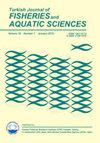Impact of Various Dietary Protein Levels on the Growth Performance, Nutrient Profile, and Digestive Enzymes Activities to Provide an Effective Diet for Striped Catfish (Pangasius Hypophthalmus)
IF 1.7
4区 农林科学
Q3 FISHERIES
引用次数: 1
Abstract
The present study was conducted to evaluate the effect of different dietary protein levels on digestive enzyme activities, nutrient assimilation as well as growth performance in striped catfish (Pangasianodon hypophthalmus). Fish were fed with four semi-purified formulated diets with increasing levels of protein: 30% (CP30), 35% (CP35), 40% (CP40) and 45% (CP45) for 12 weeks. At the end of the feed trial, the highest weight gain (29.88 g fish-1), specific growth rate (3.58%) and lower feed conversion ratio (1.91) were observed in fish that were fed with a 40% protein diet while CP30 treatment group had the poorest growth performance indicators (P<0.05). Proximate analysis revealed that fish fed with either CP40 (18.50%) or CP45 (19.33%) diets had the highest protein content in comparison to that fed CP30 (17.13%) and CP35 (17.00%) diets. Similarly, the highest body lipid content was CP35 (4.20%) treatment group and the lowest in CP40 (3.83%). The amino acid in the harvested fillets was also significantly higher (P<0.05) in both CP40 and CP45 dietary treatments. The increasing dietary protein level also elevated both protease and amylase activity, while lipase activity significantly decreased (P<0.05). The study revealed that a 40 % protein level diet produced from regional ingredients in the Middle East had yielded optimal growth performance and higher muscle quality in striped catfish.不同膳食蛋白质水平对条纹鲶鱼生长性能、营养成分和消化酶活性的影响,为其提供有效的膳食
本试验旨在研究饲料中不同蛋白质水平对斑纹鲶鱼(Pangasianodon hypophthalmus)消化酶活性、营养物质同化及生长性能的影响。饲喂蛋白质水平分别为30% (CP30)、35% (CP35)、40% (CP40)和45% (CP45)的半纯化配方饲料12周。饲料试验结束时,40%蛋白质组的增重最高(29.88 g鱼-1),特定生长率最低(3.58%),饲料系数最低(1.91),CP30处理组的生长性能指标最差(P<0.05)。近似分析表明,CP40(18.50%)和CP45(19.33%)饲料的蛋白质含量高于CP30(17.13%)和CP35(17.00%)饲料。同样,体脂含量以CP35组最高(4.20%),CP40组最低(3.83%)。CP40和CP45处理的收获鱼片氨基酸含量均显著高于对照组(P<0.05)。饲粮蛋白质水平的升高使蛋白酶和淀粉酶活性显著升高(P<0.05),脂肪酶活性显著降低(P<0.05)。研究表明,用中东地区原料生产的蛋白质水平为40%的饲料,条纹鲶鱼的生长性能最佳,肌肉质量更高。
本文章由计算机程序翻译,如有差异,请以英文原文为准。
求助全文
约1分钟内获得全文
求助全文
来源期刊

Turkish Journal of Fisheries and Aquatic Sciences
FISHERIES-MARINE & FRESHWATER BIOLOGY
CiteScore
3.10
自引率
0.00%
发文量
43
审稿时长
3 months
期刊介绍:
Turkish Journal of Fisheries and Aquatic Sciences" (TrJFAS) is a refereed academic journal has been published by Central Fisheries Research Institute of Turkey and Japan International Cooperation Agency (JICA), and published in English.
It aims to address research and needs of all working and studying within the many varied areas of fisheries and aquatic sciences.
The Journal publishes English language original research papers, critical review articles, short communications and technical notes on applied or scientific research relevant to freshwater, brackish and marine environments.
TrJFAS was published biannually (April & November) between 2001 and 2009. A great number of manuscripts have been submitted to the journal for review from acceptance of the SCI index. Thereby, the journal has been published quarterly (March, June, September and December) from 2010 to 2017. The journal will be published monthly in 2018.
 求助内容:
求助内容: 应助结果提醒方式:
应助结果提醒方式:


